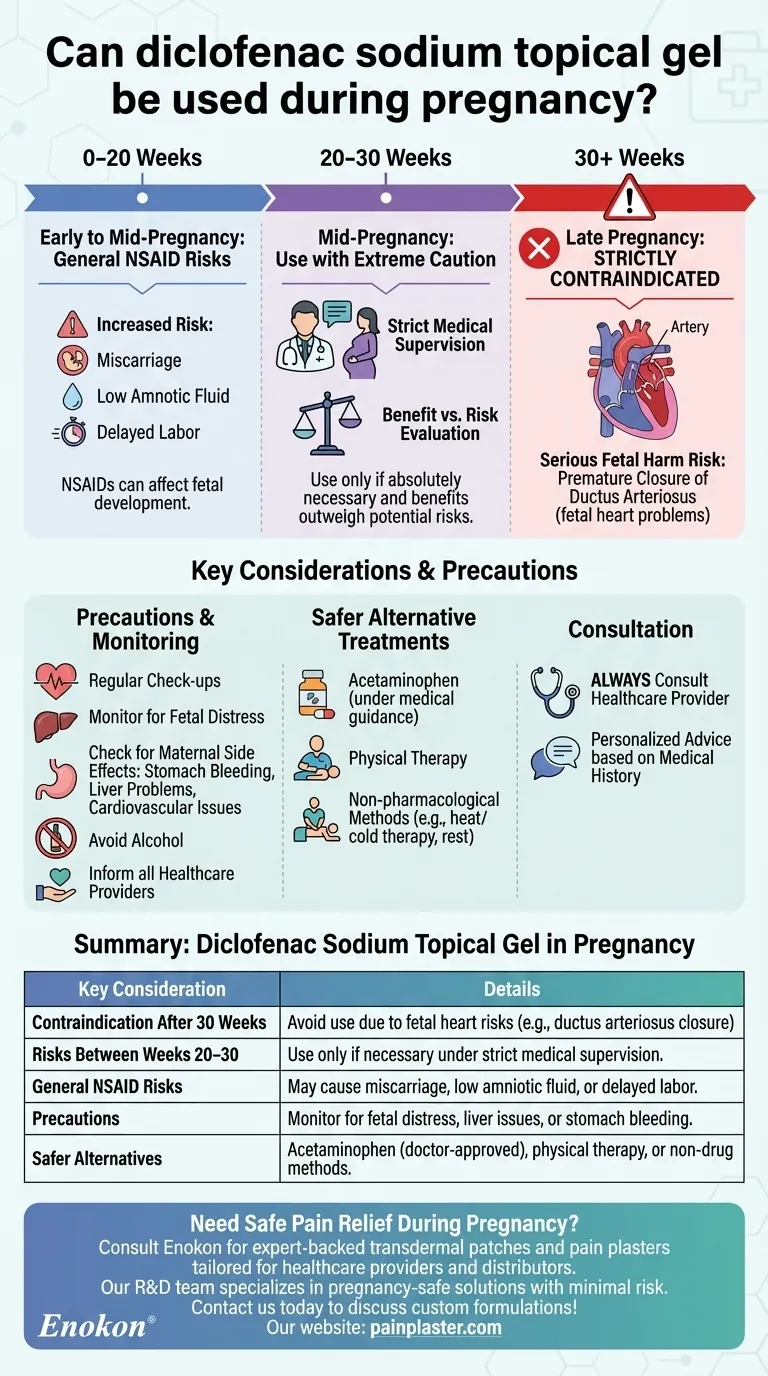The use of diclofenac sodium topical gel during pregnancy requires careful consideration due to potential risks to the unborn baby. While it may be used under medical supervision between weeks 20 and 30, it is strictly contraindicated after 30 weeks due to the risk of harm to the fetus. The decision to use this medication during pregnancy should always involve a thorough discussion with a healthcare provider, weighing the benefits against the risks. Other precautions, such as monitoring for side effects and avoiding alcohol, are also important.

Key Points Explained:
-
Contraindication After 30 Weeks:
- Diclofenac sodium topical gel should not be used after 30 weeks of pregnancy. This is due to the potential for serious harm to the unborn baby, including complications such as premature closure of the ductus arteriosus, which can lead to fetal heart problems.
-
Potential Risks Between Weeks 20 and 30:
- Even before 30 weeks, there may be risks to the fetus. Between weeks 20 and 30, the use of this medication should only be considered if absolutely necessary and under close medical supervision. The healthcare provider will evaluate whether the benefits of pain relief outweigh the potential risks.
-
General Risks of NSAIDs During Pregnancy:
- As a nonsteroidal anti-inflammatory drug (NSAID), diclofenac sodium can affect fetal development and maternal health. NSAIDs are known to increase the risk of complications such as miscarriage, low amniotic fluid, and delayed labor.
-
Precautions and Monitoring:
- If use is deemed necessary, regular check-ups with a healthcare provider are essential to monitor for any adverse effects. This includes monitoring for signs of fetal distress or maternal side effects such as stomach bleeding, liver problems, or cardiovascular issues.
-
Alternative Treatments:
- Pregnant individuals should explore safer alternatives for pain relief, such as acetaminophen (under medical guidance), physical therapy, or other non-pharmacological methods. These options may pose fewer risks to both the mother and the baby.
-
Other Important Considerations:
- Avoid alcohol while using diclofenac sodium topical gel, as it can increase the risk of stomach bleeding.
- Inform all healthcare providers, including dentists, about the use of this medication to avoid potential interactions with other treatments.
- Be aware of symptoms like upper stomach pain, yellowing of the skin or eyes, or dark urine, which could indicate liver problems.
-
Consultation with Healthcare Provider:
- The decision to use diclofenac sodium topical gel during pregnancy should always be made in consultation with a healthcare provider. They can provide personalized advice based on the individual’s medical history and the specific circumstances of the pregnancy.
Ultimately, the safety of the unborn baby is the top priority, and any medication use during pregnancy should be approached with caution and professional guidance.
Summary Table:
| Key Consideration | Details |
|---|---|
| Contraindication After 30 Weeks | Avoid use due to fetal heart risks (e.g., ductus arteriosus closure). |
| Risks Between Weeks 20–30 | Use only if necessary under strict medical supervision. |
| General NSAID Risks | May cause miscarriage, low amniotic fluid, or delayed labor. |
| Precautions | Monitor for fetal distress, liver issues, or stomach bleeding. |
| Safer Alternatives | Acetaminophen (doctor-approved), physical therapy, or non-drug methods. |
Need Safe Pain Relief During Pregnancy? Consult Enokon for expert-backed transdermal patches and pain plasters tailored for healthcare providers and distributors. Our R&D team specializes in pregnancy-safe solutions with minimal risk. Contact us today to discuss custom formulations!
Visual Guide

Related Products
- Far Infrared Deep Heat Relief Patches Medicated Pain Relief Patches
- Asthma Cough and Pain Relief Patch for Adults and Kids
- Far Infrared Heat Pain Relief Patches Transdermal Patches
- Heating Pain Relief Patches for Menstrual Cramps
- Prostate Pain Kidney Health Care Patch for Men
People Also Ask
- How do pain relief patches provide targeted relief? Discover the Science Behind Effective Pain Management
- What are pain relief patches and how are they used? A Guide to Safe, Targeted Relief
- How quickly does the Deep Heat Pain Relief Back Patch activate and how long does it provide warmth? Get 16-Hour Relief
- How do Deep Heat Pain Relief Patches provide pain relief? Discover the Drug-Free Mechanism
- How effective are pain relief patches for muscle pain? Target Localized Pain with Transdermal Delivery
















